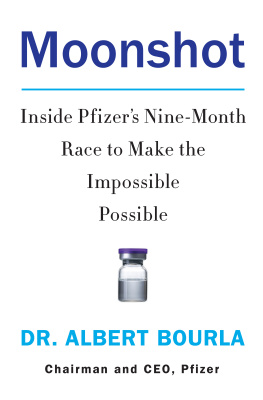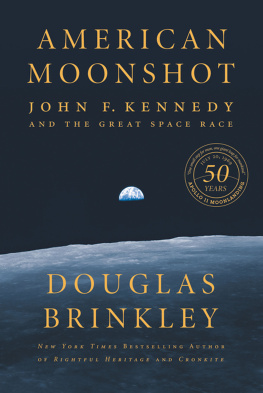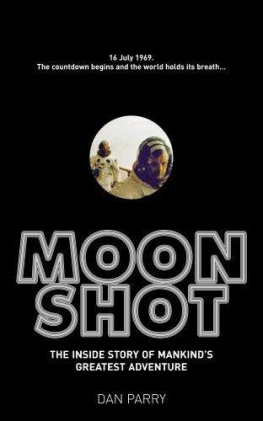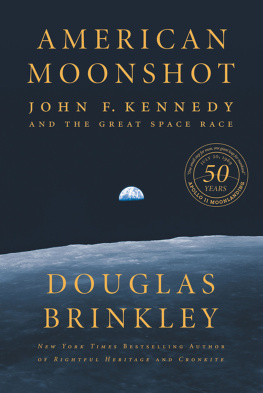Albert Bourla - Moonshot : Inside Pfizers Nine-month Race to Make the Impossible Possible
Here you can read online Albert Bourla - Moonshot : Inside Pfizers Nine-month Race to Make the Impossible Possible full text of the book (entire story) in english for free. Download pdf and epub, get meaning, cover and reviews about this ebook. year: 2022, publisher: HarperCollins, genre: Science. Description of the work, (preface) as well as reviews are available. Best literature library LitArk.com created for fans of good reading and offers a wide selection of genres:
Romance novel
Science fiction
Adventure
Detective
Science
History
Home and family
Prose
Art
Politics
Computer
Non-fiction
Religion
Business
Children
Humor
Choose a favorite category and find really read worthwhile books. Enjoy immersion in the world of imagination, feel the emotions of the characters or learn something new for yourself, make an fascinating discovery.
- Book:Moonshot : Inside Pfizers Nine-month Race to Make the Impossible Possible
- Author:
- Publisher:HarperCollins
- Genre:
- Year:2022
- Rating:3 / 5
- Favourites:Add to favourites
- Your mark:
- 60
- 1
- 2
- 3
- 4
- 5
Moonshot : Inside Pfizers Nine-month Race to Make the Impossible Possible: summary, description and annotation
We offer to read an annotation, description, summary or preface (depends on what the author of the book "Moonshot : Inside Pfizers Nine-month Race to Make the Impossible Possible" wrote himself). If you haven't found the necessary information about the book — write in the comments, we will try to find it.
Albert Bourla: author's other books
Who wrote Moonshot : Inside Pfizers Nine-month Race to Make the Impossible Possible? Find out the surname, the name of the author of the book and a list of all author's works by series.
Moonshot : Inside Pfizers Nine-month Race to Make the Impossible Possible — read online for free the complete book (whole text) full work
Below is the text of the book, divided by pages. System saving the place of the last page read, allows you to conveniently read the book "Moonshot : Inside Pfizers Nine-month Race to Make the Impossible Possible" online for free, without having to search again every time where you left off. Put a bookmark, and you can go to the page where you finished reading at any time.
Font size:
Interval:
Bookmark:
To the more than 5 million individuals who have lost their lives to COVID-19, and to their families and loved ones.
To the 250 million patients who were infected, fought, and survived.
To the more than 46,000 patients who participated in the vaccines clinical trials.
To my Pfizer colleagues and their families who made the impossible possible.
To our partners at BioNTech, and in particular Ugur ahin and zlem Treci.
To my wife, Myriam, and my children, Mois and Selise, who stood by me and supported me throughout.
IT HAS BEEN THIRTY-FIVE YEARS since my own moonshot, when I, along with my Carter Center colleagues, set out to eradicate Guinea worm disease, a horrific parasite that afflicted more than 3.5 million people primarily in impoverished parts of Africa. Today, there are fewer than thirty cases of Guinea worm disease in the world.
This goal led to the Carter Centers decades-long work to improve global health by fighting six preventable neglected tropical diseases in tens of thousands of overlooked communities that lack healthcare resources. Unlike COVID-19, which impacted nearly every living person on the planet, these diseases are mostly forgotten, therefore overlooked by the developed world.
The largest lesson learned from tackling these diseases is the importance of partnership and collaboration across sectors to drive global public health for all, and most important, to never give up.
Our work would not be possible without the innovative pharmaceutical industry. Medicine is central to eliminating and eradicating many diseases. In fact, a program of which I am most proud is the Carter Centers work to eliminate blinding trachoma in partnership with Pfizer Inc. and other organizations for more than twenty years.
We are making real progress, with eleven countries validated by the World Health Organization as trachoma-free in 2021. My hope is that we can achieve the global elimination of trachoma before the year 2030. Our collaboration with Pfizer has been fundamental to the fight against trachoma, and I am pleased to introduce the story of Pfizers COVID-19 vaccine development. It was a moonshot the world needed and is a testament to Dr. Bourla and Pfizers deeply held conviction that science will win.
Pfizer was the first company to receive US Food and Drug Administration approval for Emergency Use Authorization for a COVID-19 vaccine. Dr. Bourlas purpose-driven leadership inspired the men and women at Pfizer to make the impossible possible. They deserve our appreciation for their resolve to take on this disease. I have been fortunate enough to visit Pfizer and have seen firsthand their pride in their work. I was grateful, but not surprised, when they took on this taskbuilding hope when the world lacked it, believing in the power of science when the world doubted it, and challenging themselves to not give up.
You will marvel at the intricacies of Pfizers moonshot: what it took to discover, develop, and bring to market the first COVID-19 vaccine.
President Jimmy Carter
Plains, Georgia
Excellence is never an accident. It represents the wise choice of many alternativeschoice not chance, determines your destiny.
Aristotle, 384322 BC
ON TUESDAY, DECEMBER 31, 2019, Chinese authorities alerted the World Health Organization to a mysterious virus causing pneumonia-like illness in a small cluster of patients in the city of Wuhan. Shortly after, the novel virus was identified as SARS-CoV-2. Less than a year later, on Tuesday, December 8, 2020, nearly ninety-one-year-old Margaret Keenan received a Pfizer/BioNTech COVID-19 vaccine shot at Englands Coventry University Hospital and became the first person in the world to be vaccinated against the most devastating pandemic of the last one hundred years using messenger RNA (mRNA) technology. Wearing a cheerful Christmas sweater, she received a standing ovation by nurses and hospital workers as she was rolled through the hallway in a wheelchair. At the same time, all over the United Kingdom, people were celebrating like it was the end of a war, not the launch of a new vaccine.
The story of the nine-month moonshot that led to this glorious day takes place in those anxious times of 2020. But the story has its origins at least two and a half years earlier. On January 1, 2018, I was named Pfizers Chief Operating Officer, a position that would give me one year to prepare for an eventual transition to the top. My focus was growth, and my motto was that growth never just happensit is created. And in our industry, the only way to drive growth is by creating a meaningful, positive impact on the lives of patients. For that we had to transform Pfizer into a patient-centric organization focusing on science and innovation. I am an optimist, perhaps because my mothers brave and narrow escape from death, minutes after being lined up against a wall in front of a Nazi firing squad during the Holocaust, made me believe that nothing is impossible. But my optimism for the new Pfizer I was about to lead was grounded on a strong foundation. During the past nine years, my predecessor Ian Read, a man of strong convictions from whom I learned a lot, had turned around our research and development (R&D) engine from an organization of mediocre productivity to that of an industry leader. That gave me confidence to think really big about what to do to transform Pfizer and move really fast with executing my plans. In the twelve months that followed, before I became Chief Executive Officer, I developed the strategies, designed the organization, and decided on the executive team that would join me in our transformational journey. On the day I was named CEO, I knew exactly what I wanted to do. That day, the Pfizer board of directors called me into a conference room in a California hotel to confirm my appointment. I thanked them, smiled, and said aloud, Only in America! Only in America could a Greek immigrant with a thick accent become CEO of one of the worlds biggest corporations.
Immediately after taking over the reins, I initiated the most dramatic transformation in the history of our company. Within months, I reorganized the portfolio of our corporate businesses. We found better homes outside Pfizer for our Consumer Healthcare and Upjohn (off-patent) businesses. Those two businesses were big. In 2018, they accounted for over 25 percent of our total revenue, but the first had low market share and the second was declining. In both cases, the new homes were offering stronger and brighter prospects for these businesses than if they were to remain inside Pfizer. Our Consumer Healthcare business was merged with GlaxoSmithKlines Consumer Healthcare business in a joint venture that created the largest and best over-the-counter company in the world. Our Upjohn business was merged with Mylan to form Viatris, the largest and best specialty generic drug company in the world. The separation was not easy. Some members of my team became concerned with letting that much revenue go. We will not be the biggest anymore, someone said. We should not aim to be the biggest. We should aim to be the best, I replied. A good gardener needs to prune the tree when spring starts, I told a reporter. Pfizer is in the spring of high growth. Little did we know at the time that by letting these two predictable but slow-growing businesses go, and focusing solely on our innovative core, wed position ourselves two years later to deliver a vaccine to curb a global pandemic while reemerging as the biggest pharmaceutical company in the world. In addition to the worries about size, there were a lot of emotional concerns. Some of the most iconic brands that made Pfizer famous were part of those two businesses: Advil, Centrum, Lipitor, Norvasc, Viagra, just to mention a few. It felt that we were separating ourselves from our biggest successes. But I knew that what makes a good company great is its ability to optimize its own successes and turn the page to new and better horizons of fame.
Font size:
Interval:
Bookmark:
Similar books «Moonshot : Inside Pfizers Nine-month Race to Make the Impossible Possible»
Look at similar books to Moonshot : Inside Pfizers Nine-month Race to Make the Impossible Possible. We have selected literature similar in name and meaning in the hope of providing readers with more options to find new, interesting, not yet read works.
Discussion, reviews of the book Moonshot : Inside Pfizers Nine-month Race to Make the Impossible Possible and just readers' own opinions. Leave your comments, write what you think about the work, its meaning or the main characters. Specify what exactly you liked and what you didn't like, and why you think so.













